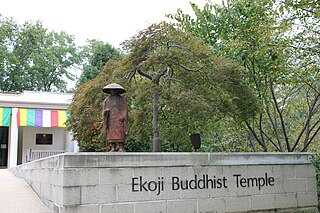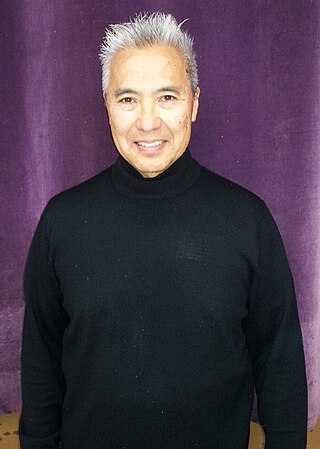Related Research Articles

Taiko are a broad range of Japanese percussion instruments. In Japanese, the term taiko refers to any kind of drum, but outside Japan, it is used specifically to refer to any of the various Japanese drums called wadaiko and to the form of ensemble taiko drumming more specifically called kumi-daiko. The process of constructing taiko varies between manufacturers, and the preparation of both the drum body and skin can take several years depending on the method.
Yamatai is a student-run taiko drumming team at Cornell University. Based in Cornell's Lincoln Hall, they perform for several events on campus and in the northeast region of the United States.

Kodō (鼓童) is a professional taiko drumming troupe. Based on Sado Island, Japan, they have had a role in popularizing taiko drumming, both in Japan and abroad. They regularly tour Japan, Europe, and the United States. In Japanese the word "Kodō" conveys two meanings: "heartbeat" the primal source of all rhythm and, read in a different way, the word can mean "children of the drum".

Ondekoza (鬼太鼓座), sometimes referred to as "Za Ondekoza", is a Japanese troupe specializing in taiko drumming.

Gocoo, or GOCOO (ゴクウ) are originally seven female and four male Taiko drummers from Tokyo (Japan). On stage Gocoo performs with up to 16 artists. Gocoo performed at major Music & Arts, Blues & Roots, Rock & Pop and alternative Rock festivals, in live clubs, classic theatres and concert halls or at techno events. Lead drummer, Kaoly Asano (浅野香), attracts much attention as a female Taiko artist. Whenever not performing with Gocoo on stage, she teaches the art of playing the Taiko at her Tawoo Taiko Dojo in Tokyo.

Ekoji is a temple of the Jōdo Shinshū Hongwanji-ha Japanese Buddhist sect in Fairfax Station, Virginia, near Washington, D.C. It is a member of the Buddhist Churches of America, the oldest Buddhist organization in the mainland United States.
Shoji Kameda is a fourth-generation Japanese American musician and composer, and leading player of North American taiko. He is a founder and member of On Ensemble, a contemporary taiko quartet, and a former member of the jazz fusion group Hiroshima.

Kenny Endo is an American musician and taiko master. He is the leader of several taiko ensembles and regularly tours, performing traditional and contemporary taiko music. Endo is also the first non-Japanese national to receive a natori in the field of hogaku hayashi, Japanese classical drumming. Today Endo composes his own music and plays taiko professionally as a solo artist, with his ensembles, and in collaboration with other artists.

Patti Jo "PJ" Hirabayashi is one of the pioneers of the North American Taiko movement. She is the founder of TaikoPeace, President of Kodo Arts Sphere America (KASA), and co-founder of Creatives for Compassionate Communities-a grassroots art-ivist group originating in San Jose, California. She is also the Artistic Director Emeritus and charter member of San Jose Taiko, the third taiko group to form in the United States. Her signature composition, "Ei Ja Nai Ka", is a celebration of immigrant life expressed in taiko drumming, dance, and voice that continues to be performed around the world.
Mark Miyoshi is a Japanese-American taiko maker. He is the owner and principal craftsman at Miyoshi Daiko, based in Mt. Shasta, California.
Kristofer Bergstrom is a leading North American taiko player. He is a former member of Los Angeles-based taiko quartet, On Ensemble. In addition to taiko, Bergstrom plays the shamisen, koto, and turntable.

Roy Hirabayashi is a Japanese American composer, performer, teacher and activist known for his work as a leader in North American Taiko. He is co-founder of San Jose Taiko, the group's former Artistic and Executive Director, and was active in developing San Jose's Japantown and arts community.
Stanford Taiko is a collegiate taiko group based at Stanford University. One of the first collegiate taiko groups to form in North America, it was founded in the winter of 1992 by students Ann Ishimaru and Valerie Mih as a way to share taiko with the university community. As the founding organization of the Intercollegiate Taiko Invitational, Stanford Taiko has been instrumental in the development of collegiate taiko throughout the United States, as well as the larger North American taiko community through performing at the Taiko Jam of the North American Taiko Conference. Since 2000, the group has been active in the international scene through tours and exchange concerts in countries such as Japan, China, and Thailand.
The Midwest Buddhist Temple Taiko group is a self-taught taiko group based in Chicago, Illinois, at the Midwest Buddhist Temple. The group started in 1977 based upon Buddhistic principals after the model of Kinnara Taiko in Los Angeles. The Midwest Buddhist Temple Taiko group performs for the temple, the Buddhist community, the Japanese American community, other communities, commercial gigs, business conferences, and different ethnic fairs. They do not consider themselves to be primarily a performing group, and they do service projects with the temple such as performing at the Midwest Buddhist Temple Ginza Holiday Festival.

Portland Taiko is a kumidaiko performance group based in Portland, Oregon, United States. Kumidaiko is the Japanese art form of ensemble drumming, also well known as "taiko", the Japanese word for drum. Portland Taiko was created in early 1994 by Ann Ishimaru and Zack Semke, both charter members of Stanford Taiko, Kyle Kajihiro, Valerie Otani, Kenji Spielman, and June Arima Schumann. Portland Taiko is an active organization to the present day and maintains professionalism in national performance tours, workshops, educational and community outreach and innovation in taiko playing. Portland Taiko is one of the only large taiko groups in the Pacific Northwest, with their closest counterpart being Seattle Kokon Taiko in Seattle, Washington.
Seattle Kokon Taiko is a North American taiko ensemble based in Seattle, Washington.
San Francisco Taiko Dojo, founded in 1968 by Grand Master Seiichi Tanaka, was the first taiko group in North America, and has been seen as the primary link between the Japanese and North American branches of the art form. Additionally, Tanaka's belief that learning to play taiko only requires a genuine interest in the art form, has greatly contributed to taiko's success and growth outside Japan.
Kinnara Taiko is a Japanese American drumming ensemble based out of Senshin Buddhist Temple in Los Angeles, US. They began playing taiko in 1969 when a few third-generation Japanese Americans gathered after an Obon festival and had an impromptu experimental session on an odaiko drum.
The Senshin Buddhist Temple is a Buddhist temple in Los Angeles, California. An affiliate of the Buddhist Churches of America (BCA), the temple was built in 1951. It is known for its maintenance of traditional practices and for cultivating one of the earliest taiko groups appearing in the United States under the leadership of Masao Kodani.

Eitetsu Hayashi is an acclaimed Japanese musician best known for his solo performance work in taiko. Hayashi joined the group Ondekoza at an early age. Later, after parting from group, helped found the taiko group Kodo, though he quickly left to begin a solo career. Hayashi has performed in notable venues such as Carnegie Hall in 1984 and was the first featured taiko performer at the institution. He is also the recipient of multiple awards recognizing the cultural value of his work.
References
- "Frequently Asked Questions." Denver Taiko FAQs. Web. 21 Feb. 2012. <http://www.denvertaiko.org/faq.html>.
- "Interview with Aiko Kimura." Telephone interview. 13 Feb. 2012.
- "Interview with Ian Berve." Personal interview. 9 Feb. 2012.
- "Interview with Joyce Nakata-Kim." Telephone interview. 19 Feb. 2012.
- "Interview with Toni Yagami." Telephone interview. 14 Feb. 2012.
- Asakawa, Gil. "NIKKEI VIEW: The Asian American Blog." Colorado Taiko Groups Drumming up Support for Japan Relief Efforts with a "Give What You Want" Concert Sat. March 26. 21 Mar. 2011. Web. 21 Feb. 2012. <http://www.nikkeiview.com/blog/2011/03/21/colorado-taiko-groups-drumming-up-support-for-japan-relief-efforts/>.